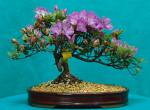
Japanese Red Maple is native to Japan and China. The leaves determine its botanical name. The bark turns brown or gray with age but is red or green when young.
The factors involved in caring for a Japanese Red Maple are these:
Location, Watering, Fertilizing, Pruning, Wiring, Repotting, Insects and diseases. I will explain these in more detail.
Do not place the Japanese Red Maple in direct sunlight. It should be placed where it will receive morning or evening sun and do not water in direct sun because the foliage can burn.
Moist soil is best for the Japanese Red Maple. They need to be watered daily with good drainage. You don't want the roots to rot from too much water and not enough drainage. You can purchase an inexpensive moisture meter to help you determine the right amount of water for your Japanese Red Bonsai tree. You can also place the pot in a tub of water about an inch deep to absorb up the holes in the bottom of the pot.
Bonsai Humidity Trays
Next you want to correctly fertilize your bonsai tree.
Fertilizers
It is very important to keeping it healthy with the right fertilizer. With each watering the the soil is washed away. When repotting do not feed for a month or two after repotting during the hottest part of the summer. You can use chemical fertlilizers if you want. You can use 20-20-20 and/or you can use or feed every 20-30 days with a slow-acting organic fertilizer in the spring and autumn.
So as not to overstress the root system you should prune the roots and branches. Prune the branches in the fall or winter, this avoids too much loss of sap. Also the shape of the tree is more pronounced. You can seal pruning wounds with a wound dressing with a putty from Japan. It's good to pinch back new growth to develop fine branches and avoid long internodes (the stem is normally divided into nodes and internodes, the nodes hold buds which grow into one or more leaves.) To avoid long internodes and develop fine branches you can pinch back the new growth. Pinch back new growth during the growing season to avoid long internodes and to develop fine branches. You want to keep the internodes short so if the branch has a long internode then you need to cut back the branch to the first internode and regrow it. Prune the leaves which involves removing the leaves during the growing season and this should be done in the early summer every other year. This will encourage smaller leaves. You want to encourage a false autumn by removing all the leaves but leaving the leaf stems. The second set of leaves will be smaller. If you repot do not leaf prune in the same year.
To shape Maples you might need to wire,
Bonsai Tools & Wire
but pruning and pinching usually shape maples. If you need to wire then do this in the summer because the tree will be in full leaf. You should protect the bark with raffia . (Raffia is long fibers from the Raffia Palm (Raphia farinifera)the wire should not be left on for more than six months. You can shape the trunk by tying it to a stake or you can keep it straight.
It is always necessary to repot bonsai trees.
Ceramic/Mica Bonsai Pots
For young trees repot every other year and for older trees repot every two or three years. You need to repot in the spring and cut the roots half their length. Remove dead roots to avoid root rot.
Of course there is always the threat of diseases and insects so you need to be prepared for that threat. These problems include mildew, root rot, and amphids. You can control amphids by spraying with for example 'Atomic Grow for Amphids' which is all natural and actually rebalances your tree. Signs of amphids are honey dew on the lower leaves and leaf drop.
Always maintain good drainage to avoid root rot and mildew.
Tools for bonsai:
Bonsai Tools & Wire
/>
RankTips - Search Engine Ranking Tips, Web Directory
















